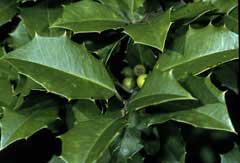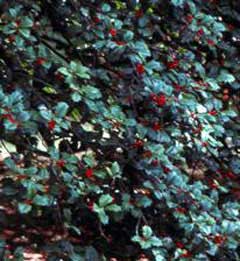 |
|
USDA-NRCS |
 |
| http://en.wikipedia.org/wiki/User:Jaknouse |
Translate this page:
Summary
Physical Characteristics

 Ilex opaca is an evergreen Shrub growing to 15 m (49ft) by 1.5 m (5ft) at a slow rate.
Ilex opaca is an evergreen Shrub growing to 15 m (49ft) by 1.5 m (5ft) at a slow rate.
See above for USDA hardiness. It is hardy to UK zone 5. It is in leaf all year, in flower from May to June, and the seeds ripen from November to December. The species is dioecious (individual flowers are either male or female, but only one sex is to be found on any one plant so both male and female plants must be grown if seed is required). and is pollinated by Bees. The plant is not self-fertile.
Suitable for: light (sandy), medium (loamy) and heavy (clay) soils. Suitable pH: mildly acid, neutral and basic (mildly alkaline) soils. It can grow in semi-shade (light woodland) or no shade. It prefers moist soil. The plant can tolerates strong winds but not maritime exposure.
UK Hardiness Map
US Hardiness Map
Synonyms
I. quercifolia. Meerb.
Plant Habitats
Woodland Garden Secondary; Dappled Shade; Shady Edge; Hedge;
Edible Uses
Edible Parts:
Edible Uses: Tea
The roasted leaves are used as a tea substitute[161, 177]. They do not contain caffeine[183]. The drink was a very popular tea substitute during the American Civil war[183].
References More on Edible Uses
Medicinal Uses
Plants For A Future can not take any responsibility for any adverse effects from the use of plants. Always seek advice from a professional before using a plant medicinally.
Antiperiodic Diuretic Emetic Epilepsy Laxative Malaria Ophthalmic Skin
The berries are laxative, emetic and diuretic[222]. They are used in the treatment of children's diarrhoea, colic and indigestion[222]. A tea made from the leaves has been used as a treatment for measles, colds etc[222, 257]. The leaves have also been used externally in the treatment of sore eyes, sore and itchy skin[222, 257]. A tea made from the bark was once used in the treatment of malaria and epilepsy[222]. It has also been used as a wash for sore eyes and itchy skin[257].
References More on Medicinal Uses
The Bookshop: Edible Plant Books
Our Latest books on Perennial Plants For Food Forests and Permaculture Gardens in paperback or digital formats.

Edible Tropical Plants
Food Forest Plants for Hotter Conditions: 250+ Plants For Tropical Food Forests & Permaculture Gardens.
More

Edible Temperate Plants
Plants for Your Food Forest: 500 Plants for Temperate Food Forests & Permaculture Gardens.
More

More Books
PFAF have eight books available in paperback and digital formats. Browse the shop for more information.
Shop Now
Other Uses
Dye Hedge Hedge Shelterbelt Wood
A number of cultivars of this species are used for hedging[200]. Fairly wind-resistant, this species is also used in shelterbelt plantings[200]. A dye has been made from the berries - the colour is not given[257]. Wood - light, tough, not strong, close grained, highly shock resistant, easily worked[82, 149, 171, 229]. A strikingly white wood, it is valued for use in veneers and inlay[274]. It weighs 36lb per cubic foot[235]. Too small for commercial exploitation, but it is valued for use in cabinet making and the interior finishes of houses[82], it is also used for making small items such as tool handles[149, 171, 229]. The wood can also be stained to imitate ebony[171].
Special Uses
Hedge Hedge
References More on Other Uses
Cultivation details
Succeeds in most soils so long as they are not water-logged. Fairly wind-resistant[200]. Plants are hardy to about -25°c[184]. A slow-growing and long-lived species in the wild[229], but it does not thrive or fruit well in British gardens[182]. Plants do not thrive in a maritime climate[188]. There are many named forms, selected for their ornamental value[182, 200]. The leaves remain on the plant for about 3 years, falling in the spring[82]. Flowers are produced on the current year's growth[229]. Resents root disturbance, especially as the plants get older[11]. It is best to place the plants into their permanent positions as soon as possible, perhaps giving some winter protection for their first year or two[K]. Plants are very tolerant of pruning and can be cut right back into old wood if required[188]. Dioecious. Male and female plants must be grown if seed is required.
References Carbon Farming Information and Carbon Sequestration Information
Temperature Converter
Type a value in the Celsius field to convert the value to Fahrenheit:
Fahrenheit:
The PFAF Bookshop
Plants For A Future have a number of books available in paperback and digital form. Book titles include Edible Plants, Edible Perennials, Edible Trees,Edible Shrubs, Woodland Gardening, and Temperate Food Forest Plants. Our new book is Food Forest Plants For Hotter Conditions (Tropical and Sub-Tropical).
Shop Now
Plant Propagation
Seed - best sown as soon as it is ripe in the autumn in a cold frame. It can take 18 months to germinate. Stored seed generally requires two winters and a summer before it will germinate and should be sown as soon as possible in a cold frame. Scarification, followed by a warm stratification and then a cold stratification may speed up the germination time[78, 80]. The seedlings are rather slow-growing. Pot them up into individual pots when they are large enough to handle and grow them on in light shade in a cold frame for their first year. It is possible to plant them out into a nursery bed in late spring of the following year, but they should not be left here for more than two years since they do not like being transplanted. Alternatively, grow them on in their pots for a second season and then plant them out into their permanent positions in late spring or early summer. Give them a good mulch and some protection for their first winter outdoors. Cuttings of almost ripe wood with a heel, August in a shaded position in a cold frame. Leave for 12 months before potting up. Layering in October. Takes 2 years.
Other Names
If available other names are mentioned here
Native Range
NORTHERN AMERICA: United States (Connecticut (south), Massachusetts, New Jersey, New York (southeast), Ohio (south), Pennsylvania (south), Rhode Island, West Virginia, Missouri (southeast), Oklahoma, Alabama, Arkansas, Delaware, Florida, Georgia, Kentucky, Louisiana, Maryland, Mississippi, North Carolina, South Carolina, Tennessee, Virginia, Texas).
Weed Potential
Right plant wrong place. We are currently updating this section.
Please note that a plant may be invasive in one area but may not in your area so it's worth checking.
Conservation Status
IUCN Red List of Threatened Plants Status :

| Related Plants
|
| Latin Name | Common Name | Habit | Height | Hardiness | Growth | Soil | Shade | Moisture | Edible | Medicinal | Other |
| Ilex aculeolata | | Shrub | 3.0 |
-
| | LMH | SN | M | 1 | 0 | |
| Ilex aquifolium | Holly, English holl, Christmas Holly, Common Holly, English Holly | Shrub | 9.0 |
5-9
| S | LMH | FSN | DM | 2 | 2 | 4 |
| Ilex asprella | | Shrub | 3.0 |
-
| | LMH | SN | M | 0 | 2 | |
| Ilex cassine | Cassine, Dahoon, Cassine Holly | Tree | 10.0 |
7-11
| S | LMH | SN | M | 1 | 1 | 2 |
| Ilex chapaensis | | Shrub | 10.0 |
-
| | LMH | SN | M | 1 | 0 | |
| Ilex coriacea | Large Gallberry | Shrub | 3.0 |
6-9
| | LMH | SN | M | 1 | 0 | |
| Ilex cornuta | Horned Holly, Chinese holly | Shrub | 4.0 |
7-9
| M | LMH | SN | M | 1 | 2 | |
| Ilex crenata | Japanese Holly, Box Leaved Holly | Shrub | 5.0 |
6-8
| S | LMH | SN | M | 1 | 0 | 3 |
| Ilex glabra | Inkberry | Shrub | 3.0 |
3-7
| S | LMH | SN | M | 1 | 0 | 2 |
| Ilex integra | Mochi Tree | Tree | 6.0 |
6-9
| | LMH | SN | M | 1 | 0 | |
| Ilex latifolia | Tarajo | Tree | 10.0 |
6-9
| | LMH | SN | M | 1 | 0 | |
| Ilex macropoda | | Tree | 13.0 |
6-9
| | LMH | SN | M | 1 | 0 | |
| Ilex pedunculosa | | Shrub | 10.0 |
4-8
| | LMH | SN | M | 1 | 1 | 3 |
| Ilex pubescens | | Shrub | 3.5 |
7-10
| | LMH | SN | M | 0 | 2 | |
| Ilex purpurea | | Tree | 12.0 |
7-10
| | LMH | SN | M | 0 | 2 | |
| Ilex rotunda | Kurogane holly | Tree | 20.0 |
6-9
| | LMH | SN | M | 0 | 1 | |
| Ilex verticillata | Winterberry, Common winterberry | Shrub | 2.0 |
3-7
| S | LMH | SN | MWe | 1 | 3 | |
| Ilex vomitoria | Yaupon Holly, | Shrub | 6.0 |
6-9
| S | LMH | SN | M | 1 | 1 | 3 |
| Ilex x altaclerensis | Holly | Shrub | 4.0 |
5-9
| S | LMH | SN | M | 0 | 0 | 3 |
| Ilex yunnanensis | | Shrub | 4.0 |
5-9
| | LMH | SN | M | 0 | 1 | |
| Quercus ilex | Holly Oak, Evergreen Oak | Tree | 25.0 |
7-10
| S | LMH | SN | M | 5 | 2 | 3 |
| Quercus ilex ballota | Holm Oak | Tree | 25.0 |
6-9
| S | LMH | SN | M | 5 | 2 | 3 |
|
Growth: S = slow M = medium F = fast. Soil: L = light (sandy) M = medium H = heavy (clay). pH: A = acid N = neutral B = basic (alkaline). Shade: F = full shade S = semi-shade N = no shade. Moisture: D = dry M = Moist We = wet Wa = water.
Now available:
Food Forest Plants for Mediterranean Conditions
350+ Perennial Plants For Mediterranean and Drier Food Forests and Permaculture Gardens.
[Paperback and eBook]
This is the third in Plants For A Future's series of plant guides for food forests tailored to
specific climate zones. Following volumes on temperate and tropical ecosystems, this book focuses
on species suited to Mediterranean conditions—regions with hot, dry summers and cool, wet winters,
often facing the added challenge of climate change.
Read More
Expert comment
Author
Sol. ex Aiton.
Botanical References
1143200
Links / References
For a list of references used on this page please go here
Readers comment